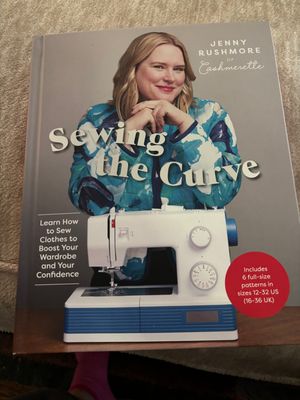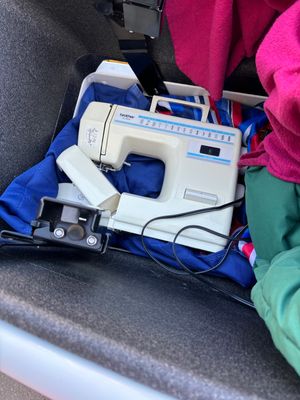Taking an old sewing machine in for repair
March 7, 2024
I have been wanting to (re)learn to sew, and specifically to sew my own clothing, which I have never done before. I have a machine that I claimed from my mom long ago, but I haven't used it in years.
In middle school or so, I learned to sew at my neighbor's kitchen table. She had been a home economics teacher for many years and an extension educator, but our school no longer had home ec, and I was not in 4-H where the sewing classes were advertised. So I would carry my mom's machine next door to her house, and she taught me to sew and press. I made a little bag and a pillow. It was really nice! I was comfortable with my neighbor because her grandkids from a different town were my age and we would play a lot when they were visiting, but we hadn't spent a lot of time alone together before that. I am so grateful that she took me under her wing to teach me to sew!
Later, my own grandmother helped me make a quilt top in a nice log cabin pattern. When we were picking out the fabric, she said to wait to buy the backing and batting until I had finished the top. It was a Quilt-in-a-Day pattern, and I did indeed finish the top in a single weekend! It is still just a top, however, because I never did make it back to the store for the backing and batting.

I picked up a copy of Jenny Rushmore's book Sewing the Curve recently at my local bookstore, and read it cover to cover immediately. I learned so much, and the task of garment sewing started to feel much more attainable, even as it remains a daunting process. I'd definitely recommend this book as a first resource if you are wanting to learn to sew clothing, too!
People say sometimes that when you sew your own clothes you can customize the fit, but I didn't really know what that meant beyond maybe customizing the length. I did not know that you can do a lot more stuff when you sew your own clothes than simply pick the size of pattern you want from what the patternmaker decides is the sizes to offer. Combining different pattern sizes (I need X in the hips but Y at the waist and Z in the chest for a dress, for example) or modifying various parts to get a truly custom fit turns out to be actually a standard and not-overly-advanced part of garment sewing even for novices/hobby sewists!! I am very excited at this prospect. (Jenny Rushmore's second book, Ahead of the Curve, on customizing fit specifically for people in bigger bodies, is high on my wish list if this whole sewing thing keeps my interest.)
I am planning to make the Montvale dress from Sewing the Curve. It's a dress in a woven fabric, and I will make it with the drop sleeves that are on the tunic-length "view" of the pattern, and use the pockets/length from the dress view. I purchased some fabric from Joann's and the first challenge was washing the fabric. I know (from reading!) that it's best to finish the raw edges of woven fabrics before you throw them in the washing machine to pre-wash. So I did that, but it was much harder than I expected!
I thought it was a me-problem, or that I was mis-remembering or misunderstanding how the machine should work. But the go-backwards button on my machine seemed to be fully non-functional, so I decided to take the machine in for a repair. And there (at Randolph Sew-Vac here in Lincoln) I learned my machine is well and truly messed up in ways that made sewing a straight line of zig-zags across the edges of my fabric much harder than it should have been!
The guy at the repair shop who said he has been in business for 30 years or so was very excited by my machine, and the fascinating problems it contained. My mom's old Brother 3010 is apparently one of the last metal-framed machines that were produced before the industry switched to plastic-bodied machines. (The outside is plastic on both; I had no idea it was metal inside!) He said it was a very good entry-level machine even though it was sold fairly cheaply when it came out. He thought it would take about $175 to fix, and promised that if I invested in the repair, I'd come home with a much better machine than I could buy brand new for that price.
He told me the timing of the machine, which is intended to be extremely precise, is a full 180 degrees out of tune, which he found quite funny.
In between taking a few phone calls for the shop, he taught me a lot about how sewing machines work. I asked him if he could help me find a walking foot attachment that would be compatible with my machine, and he immediately demanded "Who told you you needed that?? You don't!" He said ladies always come in from their quilting classes and say they need one, and he tries to explain that it will be hard on the machine and make it wear out more quickly and require expensive repairs, but the ladies never listen. He grabbed a walking foot nearby and did a little demonstration of how it worked - basically, in order to do what it does, it puts a lot of pressure on the part that is supposed to move the needle freely up and down, and this wears out that piece much more quickly than it's supposed to. He said instead, since I am primarily interested for sewing knit fabrics, a better move would be to raise the feed dog parts by a tiny fraction of an amount, which will make them grippy enough to grab the more slippery and stretchy fabrics a bit better. (This was an add-on to my repair, for $10, but he said it would be easier to do now while the machine is all torn apart my him than later.)
Next he went on to inform me about the importance of buying high quality needles. They sell needles now in the stores for $2/pack or so, which is usually what price-conscious novices like me buy. (I thought guiltily about my recent trip to Joann's and how indeed, I looked for basically the cheapest needles that seemed to match my requirements.) He told me how some needles say "Sharps" on the package and isn't that a bit strange, shouldn't all needles be sharp? Well, the reason is that needles should be (and in past decades, always were) hardened through a special process that makes them both extra hard, and able to be made extra pointy because of how the extra heat process changes the metal structure. But the process is somewhat more expensive and annoying for manufacturers, and consumers (me) want cheap stuff, so some manufacturers stopped taking that step. So they can sell needles much more cheaply, but the needles aren't as sharp, and break or wear down more easily, which rips the fabric. Then people come in and say "I need the smallest (diameter) needle you have, my fabric keeps ripping!" and he has to explain that it's not the needle shaft that's the problem, it's the insufficient pointiness of the cheap needles.
Schmetz Microtex is acceptable, he says, and Organ needles are good but hard to find now in most stores. He says many machines you buy new ship with Organ needles, even if they are not labeled as such. Singer machines is now a separate company than Singer everything else, and even Singer machines come with a different brand of needle. (Never buy Singer needles, he says.)
The shop guy thinks Singer has gone downhill over the years, in part due to company restructurings. He begrudgingly admits that while Brother is not his favorite, they stand by their machines, as evidenced by the early-post-WWII model he pointed at near the door that they are still making parts for. He said I should have no problem getting anything I need for my machine for years to come.
I mentioned I got the machine from my mom, but she never took to sewing really, and then I used the machine in high school a bit and not since. He says “oh yeah. Your mom doesn’t sew. I can see that plain as day from this machine. Machines don’t lie.” He says ladies will come in and say they’ve been sewing a lot and he knows they really haven’t been because of how the machine looks.
I started this post after I dropped off the machine, but now I've picked it up! He said the machine is running great, and gave me a patient refresher on how to thread it correctly, even though I came in right before closing time.
For drop-off I had biked with the sewing machine in the bucket of my cargo bike, and I was worried after he had told me about the precise timing mechanisms that this was a mistake. But he told me that it would be fine to bike with the machine like that, and it won't hurt the machine at all to hit the normal bumps in the road.

Overall I have been very happy with my experience at Randolph Vac & Sew in Lincoln, and I am excited to continue my sewing journey with my trusty old machine!